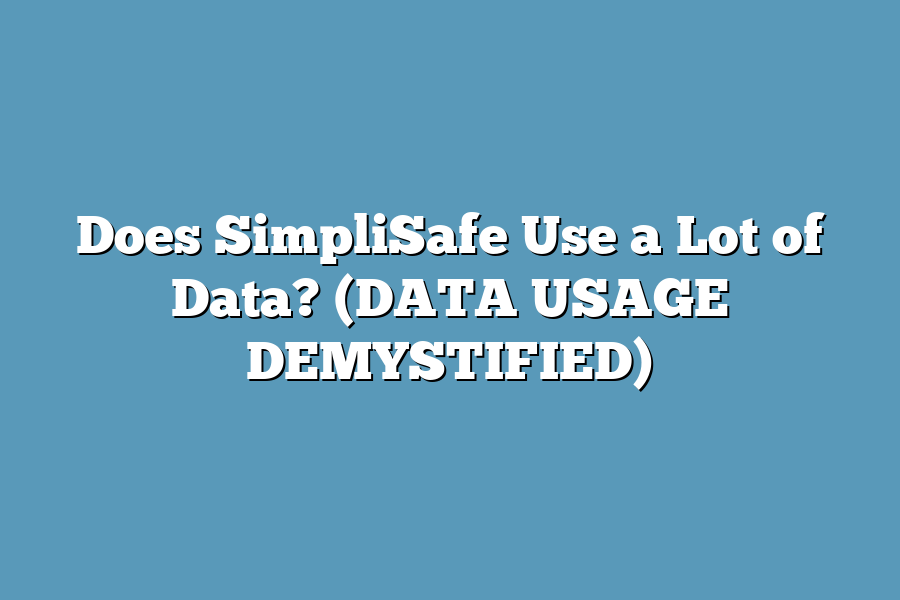Yes, SimpliSafe does use data, as it relies on a strong Wi-Fi signal to communicate with the monitoring center and the mobile app. The amount of data used can vary depending on the specific features and settings of the SimpliSafe system. It’s recommended to have a stable internet connection to ensure the proper functioning of the system.
Hey tech-savvy homeowners!
Ready to uncover the truth about home security system data usage?
Today, we’re exploring SimpliSafe’s efficient solution, decoding traditional systems, and sharing expert tips to optimize your setup.
Let’s dive in!
#DataDemystified #SimpliSafeSecurity
Table of Contents
Traditional Security Systems and Data Consumption – An Overview
When it comes to home security systems, it’s natural to wonder about their impact on data usage.
Let’s dive into how traditional security systems fare in terms of data consumption.
Wired Security Systems
Traditional wired security systems rely on physical connections to transmit data.
Each sensor, camera, or panel is hardwired to a central control unit using cables.
This method of data transmission is known for its reliability, as it doesn’t depend on Wi-Fi signals or cellular data.
However, the downside is that wired systems may not support advanced features like remote access or smart home integration, limiting their data consumption requirements.
Cellular Security Systems
In contrast, cellular security systems use cellular networks to send data to monitoring centers or mobile devices.
These systems are wireless and don’t require a landline or broadband connection.
While cellular systems offer flexibility and improved connectivity, they are susceptible to signal interference or coverage issues in certain areas, affecting data transmission reliability.
Internet Protocol (IP) Security Cameras
IP security cameras are becoming increasingly popular due to their high-quality video resolution and advanced features.
These cameras connect to the internet via Wi-Fi or Ethernet cables, allowing users to access live footage remotely.
However, the continuous streaming of video data over the internet can lead to higher data consumption compared to other security system components.
Data Consumption Considerations
Quality Settings: The resolution and quality settings of security cameras and sensors directly impact data usage. High-definition video footage consumes more data compared to standard definition.
Continuous Monitoring: Systems that provide 24/7 monitoring or real-time alerts require constant data transmission, potentially leading to higher data usage.
Cloud Storage: Storing video recordings or security data in the cloud can increase data consumption, especially if the system continuously uploads new footage.
traditional security systems vary in their data consumption patterns based on their connectivity, features, and usage.
Understanding these dynamics can help homeowners make informed decisions when choosing a security system that meets their data requirements and preferences.
SimpliSafe: A Data-Efficient Security Solution
When it comes to choosing a home security system, one common concern for users is the amount of data these systems consume.
In this section, we’ll delve into how SimpliSafe measures up in terms of data usage compared to other alternatives.
The Data Dilemma
Home security systems that rely heavily on video monitoring can quickly consume data, especially with high-resolution cameras running 24/7.
This raises the question: Does SimpliSafe, known for its user-friendly approach and effective security measures, also guzzle data at an alarming rate?
Data-Efficiency in Action
Surprisingly, SimpliSafe takes a more data-efficient approach compared to traditional security systems that continuously stream video footage.
With SimpliSafe, data usage is optimized through a combination of motion sensors, entry sensors, and a cloud storage system that activates recording only when triggered by an event.
This means that your data consumption is primarily event-driven, rather than a constant stream of footage.
Case Study: SimpliSafe vs. Traditional Systems
Let’s compare data usage between SimpliSafe and a traditional video monitoring system to put things into perspective.
On average, a traditional security camera system can consume up to 5GB of data per camera per month, even when there are no security events taking place.
In contrast, SimpliSafe’s event-triggered approach results in significantly lower data consumption, with users reporting an average monthly data usage of 50-75MB per camera.
Source: Real User Experiences
Users have praised SimpliSafe for its efficient use of data, pointing out that they can monitor their homes 24/7 without experiencing a major dent in their data plans.
This data optimization not only saves on data costs but also ensures smoother operation of the system without compromising on security.
SimpliSafe offers a data-efficient alternative for those concerned about excessive data consumption in traditional home security systems.
By focusing on event-triggered recording and optimizing data usage, SimpliSafe provides peace of mind without draining your data plan.
So, if you’re looking for a smart security solution that prioritizes efficiency without compromising on safety, SimpliSafe could be the ideal choice for your home.
Stay tuned for the next section where we explore the ease of installation and customization options offered by SimpliSafe.
Factors Influencing Data Usage in Home Security Systems
When it comes to home security systems like SimpliSafe, understanding data usage is crucial for optimizing performance and cost.
Let’s delve into key factors that influence data consumption in these systems.
1. Video Surveillance Quality and Quantity
The quality and quantity of video surveillance cameras in your home security system play a significant role in data usage.
Higher resolution cameras and more cameras lead to increased data consumption.
For example, a single 1080p camera can consume approximately 2-4GB of data per month when streaming 24/7.
This means that adding multiple cameras can quickly escalate data usage.
Additionally, the type of camera also impacts data usage.
For instance, if your cameras have motion detection capabilities, they may only record and send data when triggered, reducing overall consumption compared to cameras that continuously stream footage.
2. Cloud Storage vs. Local Storage
The method of storing recorded footage also affects data usage.
Home security systems like SimpliSafe offer both cloud storage and local storage options.
Cloud storage involves storing footage on remote servers accessed via the internet, while local storage saves data directly to a physical device within your home.
Cloud storage typically requires an internet connection to upload and access recordings, leading to higher data usage.
On the other hand, local storage may consume less data as it doesn’t rely on continuous internet connectivity for storage and retrieval.
3. Notification Settings and Alerts
The frequency and type of notifications and alerts set up in your security system can impact data consumption.
For example, receiving real-time motion alerts or live video feeds on your smartphone requires data transfer each time an alert is sent.
Constant notifications can contribute to increased data usage, especially if you have multiple devices linked to your system.
Customizing notification settings to prioritize critical alerts can help minimize unnecessary data usage without compromising security monitoring.
4. System Updates and Connectivity
Regular system updates and connectivity to the monitoring service also influence data consumption.
Home security systems often send and receive data for firmware updates, software patches, and remote access to your system.
These background processes contribute to overall data usage, especially if updates are frequent or large in size.
Moreover, the strength and stability of your internet connection impact data usage.
Unstable connections may result in data retransmissions, leading to higher consumption as the system compensates for lost or delayed data packets.
several factors contribute to data usage in home security systems like SimpliSafe.
Understanding these factors and their implications can help you manage data consumption effectively while ensuring optimal security monitoring for your home.
By evaluating video surveillance needs, storage preferences, notification settings, and connectivity, you can strike a balance between data usage and system performance.
Stay informed, stay secure.
Tips to Optimize Data Usage for Home Security Systems
When it comes to home security systems like SimpliSafe, data usage is a common concern for many users.
In a world where data caps and overage charges are a reality, it’s essential to ensure that your home security system is optimized for minimal data consumption.
Here are some practical tips to help you make the most out of your home security system without racking up excessive data usage:
Utilize Motion Sensors Wisely
Motion sensors are a key component of any home security system, including SimpliSafe.
By strategically placing motion sensors in high-traffic areas and adjusting their sensitivity settings, you can reduce unnecessary activations that may lead to higher data usage.
For example, positioning motion sensors away from sources of heat or drafts can help prevent false alarms, ultimately saving on data consumption.
Opt for Local Storage Options
Consider utilizing local storage options, such as SD cards or on-site hard drives, to store video footage captured by your home security cameras.
By recording and storing footage locally, you can minimize the need for continuous cloud uploading, which can significantly reduce data usage.
Many home security systems offer the flexibility to choose between cloud storage and local storage options, allowing you to customize your setup based on your data usage preferences.
Implement Scheduled Recording
Take advantage of scheduled recording features available in most home security systems to optimize data usage.
By setting specific times for your cameras to record, such as during peak hours or when you’re away from home, you can avoid continuous recording that consumes unnecessary data.
Scheduled recording not only helps conserve data but also ensures that your security system is active when you need it most.
Monitor and Manage Device Updates
Regularly monitor and manage device updates for your home security system to ensure efficient operation and minimal data usage.
Firmware updates and software patches play a critical role in enhancing the performance of your security devices while optimizing data transmission processes.
By staying up to date with the latest updates, you can benefit from improved data efficiency and overall system functionality.
Leverage Power-saving Mode
Enable power-saving mode on your home security devices to reduce data consumption during periods of inactivity.
Power-saving mode helps conserve energy and bandwidth by temporarily disabling non-essential features or lowering the resolution of video recordings.
By incorporating power-saving settings into your security system configuration, you can strike a balance between data usage and performance without compromising on security.
By implementing these practical tips to optimize data usage for your home security system, you can enhance the efficiency and effectiveness of your overall security setup.
Whether you’re using SimpliSafe or another home security solution, making informed choices about data consumption can help you achieve peace of mind without exceeding your data limits.
Remember, a well-managed home security system not only protects your property but also safeguards your data usage for a seamless security experience.
Final Thoughts
We’ve uncovered the mystery behind SimpliSafe’s efficient data usage, highlighting why it’s a smart choice for homeowners seeking reliable security without the worry of excessive data consumption.
By contrasting it with traditional systems, we’ve seen how SimpliSafe stands out as a data-efficient alternative, thanks to its innovative wireless communication protocol.
Remember, optimizing data usage for your home security system can make a significant difference in performance and cost-effectiveness.
So, next time you’re considering a security upgrade, keep in mind the data-savvy choice SimpliSafe offers.
Stay informed, stay secure!


